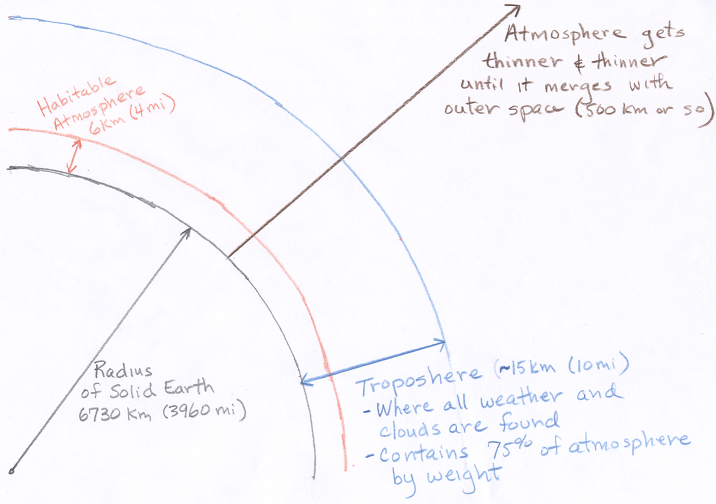
Looking toward the horizon at sunset. Most of the atmosphere (in terms of number of gas molecules) is contained in the thin reddish layer at the bottom, which is known as the troposphere. Notice the distant thunderstorm clouds poking upward. The bluish layer at the top is due to scattering of sunlight by gas molecules. Moving away from the surface of the Earth, the gas density falls off very rapidly. The darkness of outer space is seen above the top of the atmosphere. |

Simple drawing showing the relative thinness of Earth's atmosphere compared to the size of the solid and liquid sphere of the Earth. The habitable atmosphere refers to the altitude region over which humans can survive (from the ground surface up to only 6 km). The troposphere is the lowest layer of Earth's atmosphere (from the ground surface up to 15 km) and is the layer where all weather takes place. Beyond the troposphere, the gases in the atmosphere become increasingly spread out (less dense). At about 500 km above the ground, it is difficult to tell if you are in the atmosphere or outer space. |
An atmosphere is a layer of gases that surounds a planet. Earth's atmosphere is relatively thin in vertical extent compared to the size of the solid part of the planet (see figures above). In the figure on the right, the "habitable atmosphere" refers to the portion of the atmosphere where humans can survive without breathing assistence, which extends up to only about 6 kilometers (or 4 miles) above sea level. Thus in order to survive without breathing assistance, we cannot venture more than about 6 km above sea level. Think about how short 6 kilometers seems when moving along a horizontal path. People often use the term "thin air" to describe the air at high alitudes, where "thin" refers to the density of air (the number of gas molecules that is contained in a given volume, like the volume of your lungs for example). It gets more difficult to breath as the air becomes "thinnner" or less dense. In the atmosphere, the gas density is highest at the surface and gets lower and lower as one moves away from the surface until at some point (on the order of a few hundred kilometers above sea level), the gas density is so low that it is difficult to determine whether you are still in the Earth's atmosphere or in outer space. As we will see, most of Earth's atmosphere is compressed together and sits right above the Earth's surface. The troposphere, which contains 75% of the total weight of the atmosphere, extends only up to about 15 km above the ground. Additionally, all weather is confined in the troposphere. The top of the troposphere is sometimes reached by towering thunderstorm clouds.
The atmosphere is retained by Earth's gravity. The mixture of gases that is found on Earth today is commonly called air. Beside gases, the atmosphere also contains very minute quantities of microscopically small suspended particles of solid and liquid (called aerosols), which includes things like dust, pollen, and cloud droplets. Most aerosols are much too small to see individually. However, when concentrations of aerosols are high, such as the microscopic liquid droplets that make up clouds or heavy smoke from a fire, the combined effect of concentrated microscopic particles can be seen. Gases are composed of individual molecules that are not chemically bonded together. The gas molecules and suspended aerosols are individually very tiny and have very little mass. Thus, they have very little weight on Earth compared with the solid and liquid substances, which are composed of countless numbers of chemically bonded molecules, that compose the Earth's ground surface. In essence, the larger and heavier solids and liquids sink to the bottom, and the gases (the atmosphere) float to the top and become the outer layer surrounding the Earth. Not all planets have atmospheres of gas surrounding them, while many other planets have much more massive atmospheres than the Earth. Living on the surface of the Earth (at the bottom of our atmosphere), we have become so adapted to our particular atmosphere that we cannot survive more than a few minutes without it. Just as fish need to be surrounded in an environment of water to survive, we must be surrounded in an environment of air. And anywhere we go, e.g., under water, outer space, etc., we must have air with us for long-term survival.
Meteorology is the study of the atmosphere and the processes (such as cloud formation, lightning, and the movement of the wind) that cause what we refer to as the "weather". Most of the world's weather systems and their related features, including clouds and rain, develop in the lowest layer of the atmosphere, called the troposphere. Such weather systems, or patterns of air movement, develop as a result of the flow of heat from warmer regions of the Earth near the equator to colder regions nearer the poles. The air, and the heat it carries however, does not flow in a straight line, because of the Earth's rotation. As a consequence, the air flow is deflected, forming the swirling patterns of air circulation we observe on Earth.
Despite its relative thinness, our existance is completely dependent upon the atmosphere. Essential functions of the atmosphere include:
The atmosphere also influences our existance in several non-life essential ways: